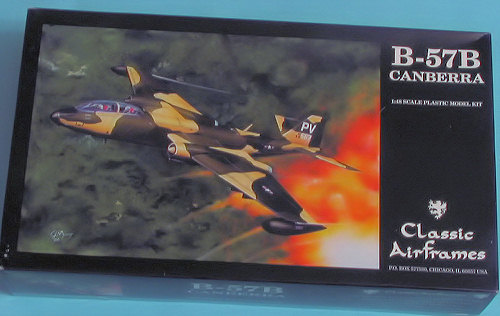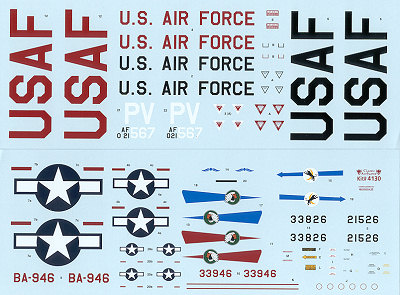
| KIT: | Classic Airframes 1/48 B-57B Canberra |
| KIT #: | 4130 |
| PRICE: | $69.00 MSRP |
| DECALS: | Three options |
| REVIEWER: | Scott Van Aken |
| NOTES: | Short run with resin parts |

| HISTORY |
At the outbreak of the Korean War in 1950, the United States Air Force found itself in dire need of an all-weather interdiction aircraft. The piston-engined Douglas A-26 Invaders were limited to daytime and fair weather operations and were in short supply. Thus, on 16 September 1950 the USAF issued a request for a jet-powered bomber with a top speed of 630 mph (1,020 km/h), ceiling of 40,000 feet (12,190 m), and range of 1,150 miles (1,850 km). Full all-weather capability and secondary reconnaissance role had to be included in the design. To expedite the process, only projects based on existing aircraft were considered. The contenders included the Martin XB-51, and the North American B-45 Tornado and AJ Savage. In an extremely rare move, foreign aircraft including the Canadian Avro Canada CF-100 Canuck and the British English Electric Canberra were also given consideration. The AJ and B-45 were quickly dismissed because their outdated designs had limited growth potential. The CF-100 was too small and lacked sufficient range. The XB-51, while very promising and much faster, had limited maneuverability, a small weapons bay, and limited range and endurance.
On 21 February 1951, a British Canberra B.2 became the first-ever jet to make a non-stop unrefuelled flight across the Atlantic Ocean, arriving in the United States for USAF evaluation. The Canberra emerged a clear winner of the 26 February flyoff against the XB-51. Since English Electric was unable to produce enough aircraft for both the RAF and the USAF, on 3 April 1951 Martin was granted the license to build Canberras, designated B-57 (Martin Model 272) in the US. To expedite production, the first B-57As were largely identical to the Canberra B.2s with the exception of more powerful Armstrong Siddeley Sapphire engines of 7,200 lbf (32 kN) of thrust, also license-built in the US as Wright J65s. In addition, canopy and fuselage windows were slightly revised, the crew was reduced from three to two, wingtip fuel tanks were added, engine nacelles were modified with additional cooling scoops, and the conventional "clamshell" bomb-bay doors were replaced with a low-drag rotating door originally designed for the XB-51.
The first production aircraft flew on 20 July 1953, and was accepted by USAF on 20 August. During the production run from 1953 to 1957, a total of 403 B-57s were built. This was the first aircraft of non-US design to be built for the US military in the US since the DH-4 of 1918.
| THE KIT |
 By now you all know that Classic Airframes kits are contracted out. This one has been done by Sword for production. The result of this is that you pretty well know what to expect and this kit is no exception. The plastic parts of the kit are well molded with nicely done engraved panel lines. The plastic is thicker than on some of the kits we see from Revell or Hasegawa, but that is the nature of a short run kit. You will also have somewhat more prominent mold seams to sand down and there are small ejector towers on the inside of all the larger parts such as fuselage halves and wings. These are all easily removed with sprue cutters and sanding or just by sanding. I also found several areas where the plastic shrunk while cooling, leaving sink areas. These were confined to the thicker bits like outside gear doors and wing pylons. This isn't universal on all kits and your findings may vary. There are also several bits on the sprues that won't be used as they are for the other versions. There is also a clear sprue that contains the canopy and wing tip lights. The clear bits are somewhat distorted and a tad thick, but are otherwise nicely done. I'm sure some would prefer a bit crisper molding on the frame lines, but I think they are fine as they are.
By now you all know that Classic Airframes kits are contracted out. This one has been done by Sword for production. The result of this is that you pretty well know what to expect and this kit is no exception. The plastic parts of the kit are well molded with nicely done engraved panel lines. The plastic is thicker than on some of the kits we see from Revell or Hasegawa, but that is the nature of a short run kit. You will also have somewhat more prominent mold seams to sand down and there are small ejector towers on the inside of all the larger parts such as fuselage halves and wings. These are all easily removed with sprue cutters and sanding or just by sanding. I also found several areas where the plastic shrunk while cooling, leaving sink areas. These were confined to the thicker bits like outside gear doors and wing pylons. This isn't universal on all kits and your findings may vary. There are also several bits on the sprues that won't be used as they are for the other versions. There is also a clear sprue that contains the canopy and wing tip lights. The clear bits are somewhat distorted and a tad thick, but are otherwise nicely done. I'm sure some would prefer a bit crisper molding on the frame lines, but I think they are fine as they are.
The resin parts are very well done and my samples were free from mold faults. The parts molded are what I'd call older technology in terms of resin parts. Some other resin makers are molding their parts so that there is only a small sprue attachment point, even for larger castings. In this case, most parts are attached to large resin 'slabs', meaning that it will take more time to remove the bits in preparation for use. Most of the cockpit is in resin as are the wheels, engine compressor faces, exhaust and the wheel wells. Test fitting the wheel wells showed that there is a key to help get them properly aligned. I didn't notice a similar aid for the cockpit, though there is a coaming that fits in before installing the tub.
As you can imagine, in order to maximize the use of the molds for other variants, the nose is done separately. I test fitted the nose to a fuselage half and found that there was a good fit. The instructions show an indented section on which the nose will fit over. However, this is not the case and it is a butt join. I'd highly recommend two things. One is to glue the nose halves to the fuselage halves first. Then back up the join with a strip of plastic. This should provide a secure join and there is room for it. There is also room in the nose for weigh and the instructions recommend 6 ounces (!). Finding space for that weight will be a bit of a challenge.
Before leaving the kit description, a couple of other things. This is, I believe, the first time that a CA kit has provided pin and hole options for under wing racks and I appreciate this. I never did like the butt join bomb racks. I should also mention at this time that there are M117 bombs and napalm tanks to fill those racks. Secondly, this kit comes with the bits packaged in zip bags. Good move as it enables one to have a secure place to keep those parts not currently being worked on. I hope this trend continues.
 Instructions are typical for CA with a brief history that is the same for all variants. This is then followed by a sprues diagram and a generic color section for those paints used during construction. Throughout the assembly process is the disclaimer that one needs to dry fit all parts prior to assembly. My kit was missing the painting and markings page. An e-mail to Classic Airframes, and a week later, this arrived. Thanks for the prompt service. There are markings for four aircraft. One is the box art aircraft in the SEA camouflage scheme with the 13th BS, 35 TFW in Vietnam during 1966. Next is an overall ADC grey plane with daglo-orange bits from the 117 DSES, Kansas ANG in 1978. It seems that the ANG badges are missing, but it could also be that this particular plane didn't have them. I'm also thinking that International Orange should replace the daglo as that latter color was basically gone from the inventory by the mid 1960s. An all black aircraft from the 498th BS from 1957 is next and finally a bare metal 501 BS aircraft, circa 1954. A separate data markings sheet is provided to get all these goodies in the proper place. You get three strip sheets of decals with all the markings needed. I've not shown the red and black stripe decals shown that are for the wing walk areas. The decals are well printed and appear to be in perfect registration.
Instructions are typical for CA with a brief history that is the same for all variants. This is then followed by a sprues diagram and a generic color section for those paints used during construction. Throughout the assembly process is the disclaimer that one needs to dry fit all parts prior to assembly. My kit was missing the painting and markings page. An e-mail to Classic Airframes, and a week later, this arrived. Thanks for the prompt service. There are markings for four aircraft. One is the box art aircraft in the SEA camouflage scheme with the 13th BS, 35 TFW in Vietnam during 1966. Next is an overall ADC grey plane with daglo-orange bits from the 117 DSES, Kansas ANG in 1978. It seems that the ANG badges are missing, but it could also be that this particular plane didn't have them. I'm also thinking that International Orange should replace the daglo as that latter color was basically gone from the inventory by the mid 1960s. An all black aircraft from the 498th BS from 1957 is next and finally a bare metal 501 BS aircraft, circa 1954. A separate data markings sheet is provided to get all these goodies in the proper place. You get three strip sheets of decals with all the markings needed. I've not shown the red and black stripe decals shown that are for the wing walk areas. The decals are well printed and appear to be in perfect registration.
| CONCLUSIONS |
Overall this looks to be a very nice kit. Those I know who are building it report no real problems, and that is quite encouraging. This kit will not be reissued and if you haven't already gotten one, you will have but one place to find it. In a Walmart-like move, MMD bought the entire stock of kits not already promised to others. With the Airfix Canberra delayed for who knows how long, this may be your only opportunity to build this aircraft in this scale.
| REFERENCES |
January 2007
You can thank those who owe me money for this one.
If you would like your product reviewed fairly and quickly by asite that has nearly 350,000 visitors a month, please contactme or see other details in the